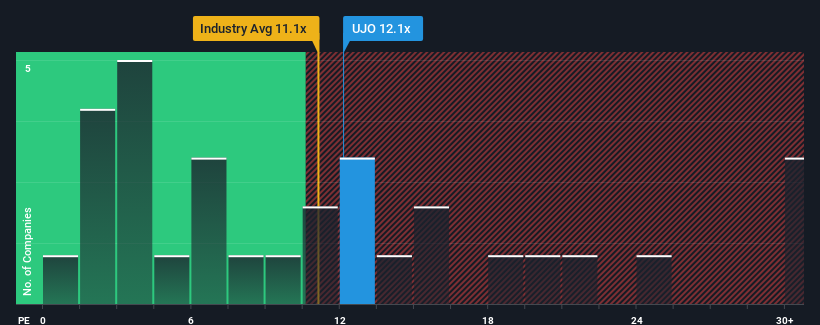- United Kingdom
- /
- Oil and Gas
- /
- AIM:UJO
Investors Still Aren't Entirely Convinced By Union Jack Oil plc's (LON:UJO) Earnings Despite 26% Price Jump

Union Jack Oil plc (LON:UJO) shareholders have had their patience rewarded with a 26% share price jump in the last month. Unfortunately, the gains of the last month did little to right the losses of the last year with the stock still down 29% over that time.
In spite of the firm bounce in price, Union Jack Oil's price-to-earnings (or "P/E") ratio of 12.1x might still make it look like a buy right now compared to the market in the United Kingdom, where around half of the companies have P/E ratios above 17x and even P/E's above 29x are quite common. Nonetheless, we'd need to dig a little deeper to determine if there is a rational basis for the reduced P/E.
Union Jack Oil hasn't been tracking well recently as its declining earnings compare poorly to other companies, which have seen some growth on average. It seems that many are expecting the dour earnings performance to persist, which has repressed the P/E. If this is the case, then existing shareholders will probably struggle to get excited about the future direction of the share price.
Check out our latest analysis for Union Jack Oil

Is There Any Growth For Union Jack Oil?
The only time you'd be truly comfortable seeing a P/E as low as Union Jack Oil's is when the company's growth is on track to lag the market.
Retrospectively, the last year delivered a frustrating 48% decrease to the company's bottom line. At least EPS has managed not to go completely backwards from three years ago in aggregate, thanks to the earlier period of growth. So it appears to us that the company has had a mixed result in terms of growing earnings over that time.
Turning to the outlook, the next three years should generate growth of 39% each year as estimated by the three analysts watching the company. That's shaping up to be materially higher than the 14% each year growth forecast for the broader market.
In light of this, it's peculiar that Union Jack Oil's P/E sits below the majority of other companies. It looks like most investors are not convinced at all that the company can achieve future growth expectations.
The Bottom Line On Union Jack Oil's P/E
The latest share price surge wasn't enough to lift Union Jack Oil's P/E close to the market median. Typically, we'd caution against reading too much into price-to-earnings ratios when settling on investment decisions, though it can reveal plenty about what other market participants think about the company.
We've established that Union Jack Oil currently trades on a much lower than expected P/E since its forecast growth is higher than the wider market. There could be some major unobserved threats to earnings preventing the P/E ratio from matching the positive outlook. At least price risks look to be very low, but investors seem to think future earnings could see a lot of volatility.
Having said that, be aware Union Jack Oil is showing 5 warning signs in our investment analysis, and 1 of those can't be ignored.
If these risks are making you reconsider your opinion on Union Jack Oil, explore our interactive list of high quality stocks to get an idea of what else is out there.
New: AI Stock Screener & Alerts
Our new AI Stock Screener scans the market every day to uncover opportunities.
• Dividend Powerhouses (3%+ Yield)
• Undervalued Small Caps with Insider Buying
• High growth Tech and AI Companies
Or build your own from over 50 metrics.
Have feedback on this article? Concerned about the content? Get in touch with us directly. Alternatively, email editorial-team (at) simplywallst.com.
This article by Simply Wall St is general in nature. We provide commentary based on historical data and analyst forecasts only using an unbiased methodology and our articles are not intended to be financial advice. It does not constitute a recommendation to buy or sell any stock, and does not take account of your objectives, or your financial situation. We aim to bring you long-term focused analysis driven by fundamental data. Note that our analysis may not factor in the latest price-sensitive company announcements or qualitative material. Simply Wall St has no position in any stocks mentioned.
About AIM:UJO
Union Jack Oil
Operates as an onshore oil and gas company in the United Kingdom and the United States.
Flawless balance sheet with high growth potential.
Market Insights
Community Narratives




